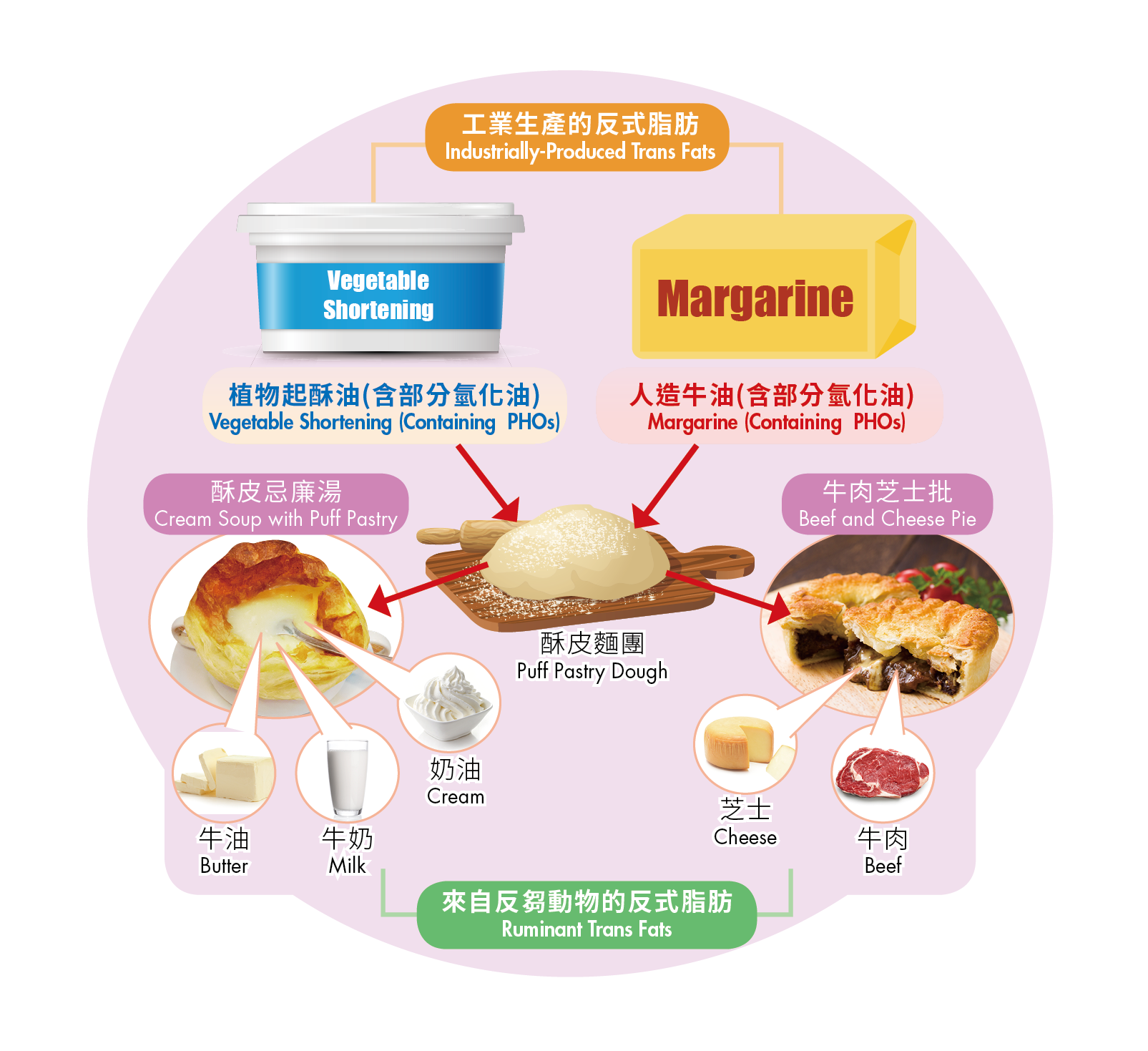
Food Safety Focus (148th Issue, November 2018) – Food Safety Platform
Industrially-Produced Trans Fats – A Double Jeopardy for Heart Health
Reported by Dr Violette LIN, Scientific Officer,
Risk Assessment Section, Centre for Food Safety
When the term “trans fats” (TFAs) is mentioned, what images surface in your mind? The lip-smacking cream soup with puff pastry from a popular fast food restaurant? The flaky yet juicy beef and cheese pie from the nearby bakery shop? Or some types of fat contributing to clogged arteries? In this article, let’s get to the bottom of TFAs, especially how the industrially-produced TFAs (IP-TFAs) becomes a double trouble for your heart health.
What Are TFAs?
TFAs are unsaturated fatty acids consisting of at least one trans double bond. Although a small amount (up to 6% of a product’s fat content) of ruminant-TFAs may be present in the meat and dairy products of ruminant animals formed in their guts, most TFAs (up to 60% of a product’s fat content) are artificially created fats used in the manufacture of foods, i.e. IP-TFAs. In the cream soup with puff pastry and the beef and cheese pie examples below, both types of TFAs may be present (see Figure 4).

TFAs may be hidden in processed foods as R-TFAs (usually small amount) and IP-TFAs (large amount, if ingredients containing partially hydrogenated oils (PHOs) have been used).
What Are IP-TFAs?
Most vegetable oils are liquids at room temperature. If hydrogen is added to oils through a process called hydrogenation, they become more solid, or 'spreadable'. Partially hydrogenated oils (PHOs) could be found in margarine or vegetable shortening.
PHOs have their commercial and food technological properties. They change the appeal of a food by enhancing its sensory profile (e.g. aroma, taste) and texture and increasing its shelf life and tolerance to repeated heating. PHOs can better withstand repeated heating without breaking down, making them ideal for frying fast foods, baking foods, and processing snack foods.
Where Are IP-TFAs Hidden in Your Food?
IP-TFAs and PHOs are found in a variety of food products. The Centre for Food Safety had conducted studies on TFAs contents in local foods between 2007 and 2018. TFAs are detected in bakery products (e.g. bread, cakes, cookies), deep fried food (e.g. French fries, fried chicken, fried fritters) and margarine/margarine-like spreads. After years of providing support to the trade and enhancing publicity, some benefits have been reaped as the trade have been producing food products with lower TFAs content.
The 2012 study comparing with the previous ones shows a reduction in the mean TFAs contents in some food categories covered. The reduction (e.g. 64% in bread, 42% in egg tart/pie/pastry and 27% in cake) reflects the positive effect of the trade's effort. While some products have reached the TFAs-free stage, others still have high TFAs level (e.g. croissants, tuna/curry puff pastries). Learning from overseas experience, it is feasible to reduce TFAs to a very low level in food but that there is still room for improvement if Hong Kong wants to eliminate IP-TFAs from the local food supply.
How Is Your Heart Health Doubly Jeopardised by TFAs?
TFAs are the worst type of fat for your heart and blood vessels through affecting your blood cholesterol levels. TFAs not only increase your “bad cholesterol”, but also decrease the “good cholesterol”.
When your body has too much “bad cholesterol”, it can build up on the walls of your blood vessels to form plaque. Over time, the plaque narrows the insides of the vessels and blocks blood flow to and from your heart and other organs. Clogged arteries greatly increase the likelihood of heart attack, stroke, and even death. Furthermore, TFAs promote inflammation and cause the inner lining of blood vessels fails to function normally. All these will impair your heart health. Contrarily, “good cholesterol” absorbs cholesterol and carries it back to the liver for removal.
How Low Should the Intake of TFAs Go?
The WHO suggests that IP-TFAs are not part of a healthy diet and should be avoided. TFAs intake should be limited to less than 1% of total energy intake, which translates to less than 2.2 g per day in a 2,000 kcal diet.
In summary, IP-TFA is a man-made harmful compound found in foods, fats and oils. TFA can clog arteries and increases the risk of coronary heart disease. In the next issue, we will discuss how the trade could produce foods with lower IP-TFAs, and consumers could reduce the intake of IP-TFAs.


